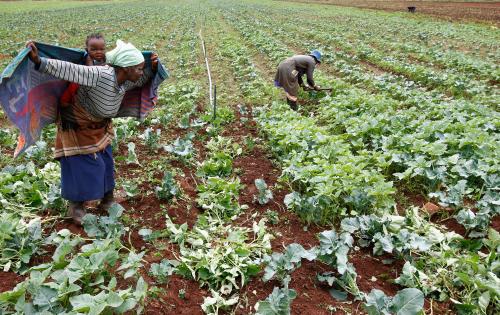On September 21, the United Nations Development Program (UNDP) launched a new report titled “Income inequality trends in sub-Saharan Africa: Divergence, determinants and consequences.” The report looks ahead to the 2030 Agenda for sustainable development and focuses on addressing inequalities in order to “leave no one behind.” A newly constructed data set covering 29 sub-Saharan African countries over 1990-2011 is used to compute the Gini coefficient.
The report finds that there is vast heterogeneity in the level of inequality across sub-Saharan Africa. Average and median inequality are higher in the region compared to other developing regions driven in part by the presence of seven countries (South Africa, Namibia, Botswana, Central African Republic, Comoros, Zambia, and Lesotho) with extremely high inequality levels. As seen in Figure 1, 10 of the 19 most unequal countries in the world are from sub-Saharan Africa.
Figure 1.
The report also analyzes the trends of the computed coefficients for countries and regions within sub-Saharan Africa between 1991 and 2011. Broadly speaking, the regional unweighted average for sub-Saharan Africa fell between 1990 and 2011—although the report notes that this fact conceals significant regional differences. As shown in Figure 2, predominantly agricultural economies in West and East Africa saw declines in inequality while oil and resource rich countries in Central and Southern Africa saw increases. Interestingly, more equal nations saw further declines whereas high-inequality nations either stagnated or rose even further.
Figure 2.
The report discusses the structural drivers of inequality pre-1991 given the high-persistence and path-dependent nature of income inequality. Some of the structural factors that explain inequality during 1991-2011 include the natural resource curse, high land concentration in settler economies of Southern and Eastern Africa, and the dualistic nature of employment with limited employment in government offices and multinational corporations contrasted with those with lower incomes in the informal sector. The inability of governments to effectively act as redistributive agents also contributes to inequality, notes the report.
Importantly, the report finds that the rate of per capita GDP growth post-1990 is less important than the sectoral patterns of growth in determining the subsequent trend in inequality. Countries where growth was driven by the mining, finance, insurance, and real estate sectors saw rising inequality compared to those that grew via the labor-intensive manufacturing, construction, or agriculture industries.
The report provides policy recommendations intended to promote more equal economic growth such as raising labor productivity and incomes in the informal sector, increasing yield and productivity in the agricultural sector, promoting value chains, improving social safety nets, and boosting human capital.
(For more policy suggestions and analysis of economic inequality in Africa, see this blog post from Haroon Bhorat: Inequality in Africa: Implications for the Sustainable Development Goals.)
The Brookings Institution is committed to quality, independence, and impact.
We are supported by a diverse array of funders. In line with our values and policies, each Brookings publication represents the sole views of its author(s).







Commentary
Figures of the week: Diverging trends on income inequality in sub-Saharan Africa
September 28, 2017